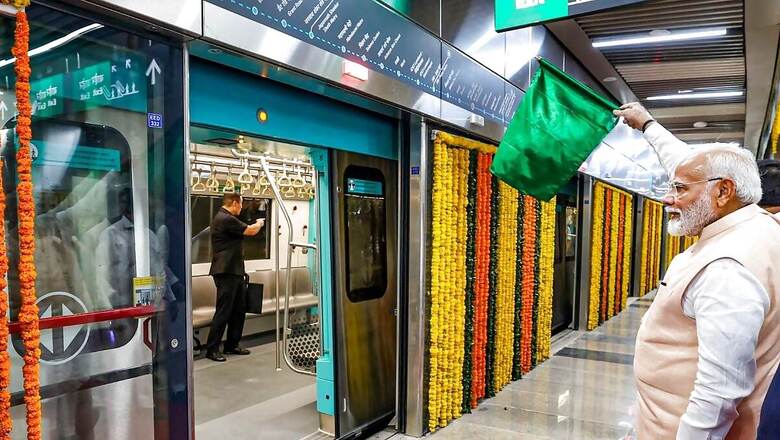
views
In the evening of October 5, history was created when the “future of urban mobility” arrived in Mumbai, the Urbs Prima in Indis — a Latin phrase that means ‘primary city of India’.
At 6pm on Saturday, Prime Minister Narendra Modi flagged off the first train to run between Bandra Kurla Complex (BKC)-Aarey-JVLR, the 12.69-kilometre stretch of Mumbai Metro Line-3, marking the arrival of ‘Mumbai Underground’.
In the Making for Over 100 Years
The railways arrived in Mumbai more than 170 years ago on April 16, 1853, when the first passenger train ran the 34-kilometer distance between Bori Bunder (Bombay) with three locomotives, named Sahib, Sultan, and Sindh, carrying 400 people in 13 carriages. With this, India became the first city in Asia to have operational railroad, barely two decades after it first ran in England.
Metro rail arrived in the world on January 10, 1863, when world’s first underground railway — London Underground — ran 3.75 miles (6 kilometres) between Paddington and Farringdon using gas-lit wooden carriages hauled by steam locomotives.
Like it happened with the railroad, had fate not intervened 100 years ago, Mumbai (then Bombay), could have become the first country in Asia (ahead of Tokyo) to get underground metro rail. The ‘Mumbai Underground’ story began when the British government tasked WR Davidge, British consulting town planner, to formulate a plan for metro rail in Bombay.
Davidge wrote in his 1922-23 recommendations: “An underground railway for the fort and adjoining business and commercial districts of Bombay would undoubtedly meet a considerable want and there is every possibility that the amount of traffic will, before long, justify the consideration of such a railway. I have carefully considered the circular route suggested by the engineer to the municipality and find myself in general agreement therewith, subject to the electrified suburban traffic being free to circulate through the whole of the city underground circle.”
The proposal, however, was not taken up by the colonial masters.
1963: A Love Story
Few Indians of this generation, including urban-transport planners, have heard the name of Dr Prabhakar Ganesh Patankar (PG Patankar). But the real dream of a cobweb of the underground metro in Mumbai was first weaved by 1925-born Patankar and doggedly pursued by him till his death in 2013.
Unbeknownst to Bharatiyas, Patankar first articulated the concrete idea of underground metro rail in Bombay in his 1963 report ‘Underground Railway for Bombay-Some Thoughts by PG Patankar’. In this report, Patankar — at his own cost — painstakingly created a comprehensive plan of five inter-connected underground Metro lines for Bombay, whose local trains and buses were already overburdened by a burgeoning population.
In the year 2000, when I was in the chokehold of bipolar disorder, apart from Metro Man E Sreedharan, Patankar was the sole other Indian who still believed I could return to normalcy. He also let me work alongside him for two years (2000-2002).
Treasured Possessions
To bring a back a semblance of normalcy to my mind, in May 2000, Patankar, apart from making me part of the TCS team to create a five-year business plan to improve BEST Bombay bus operations (a study supported by the World Bank), also gave me two seminal works for leisurely slow reading.
One was the ‘Steering Committee Report on Eastern Sea Link in Bombay’. This committee was headed by Bharat Ratna JRD Tata and Patankar was a member. Second was the ‘Underground Railway for Bombay-Some Thoughts by PG Patankar’. Patankar fondly gave me an author-signed copy of his treatise that aimed at bringing Mumbai back from the chaos of the urban-mobility gridlock.
In my subsequent manic frenzy, both the above salient works got misplaced and I have failed to get another copy of them.
Dreams Come True
Patankar worked passionately to realise the two projects. As regards the Bombay Eastern Sea Link project, I recall Patankar telling me how he dragged Ratan Tata to the office of the Maharashtra chief minister to offer that the link be constructed by Tata Group. For the underground metro in Mumbai, he would be in one or the other government office in Bombay every week, pleading that the city was transport grid-locked and the only solution was a cobweb of elaborate underground network.
When Patankar died unsung at the age of 88 at his modest home on Boat Club Road, Pune, in 2013, both the projects were still in the realm of dreams. As I write this piece, Patankar would be happy to know that both dreams have come true.
Reintroducing Patankar
On a day when Patankar’s dream of ‘Mumbai Underground’ has come true, a detour is needed to re-introduce the father of urban mobility in India to present-day Bharatiyas.
Born in 1925, Patankar first joined Indian Railways as a civil engineer before Independence in 1946. However, he returned to Bombay after a few years and fell in love with the city, joining BEST to look after urban transport and finally getting elevated to head the body. When Morarji Desai became prime minister in 1977, he took Patankar to Delhi to reboot the Delhi Transport Corporation (DTC). Saddened at the state of the incorrigible DTC, Patankar left it after two years, headed Central Road Research Institute (CRRI) for a while, and his last stint was to head the urban transport wing of Tata Consultancy Services (TCS).
When I first met Patankar in 2000, he was a sad man. He lamented the demise of vibrant green modes of Bombay mobility — trams which were discontinued on March 31, 1964, and Electric Trolly Buses that stopped working on March 24, 1972. He was also worried about the deterioration of the BEST bus operation, insufficient suburban train services, and increase of automobiles.
For him, nothing less than an elaborate network of underground metro — whose first blueprint he had made in 1963 — could save Bombay.
Back to Circa 2024
On October 5, 2024, the flagging off of the 12.69-kilometre section comprising 10 stations would have been the happiest occasion for Patankar had it come in his lifetime.
The just-opened stations of the line are on one of the heaviest-used corridors of Mumbai. Ten stations where regular commercial operations began are BKC, Bandra Colony, Santacruz, Chhatrapati Shivaji Maharaj International Airport T1, Sahar Road, CSMIA T 2, Marol Naka, Andheri, SEEPZ and Aarey Colony JVLR — the last being the only at-grade station.
This section now provides fast, comfortable, safe, secure, reliable and affordable connectivity to both terminals of Chhatrapati Shivaji Maharaj International Airport. It also has an interchange with the Ghatkopar-Andheri-Versova Metro Line 1 at Marol Naka station.
The entire 33.5-km Line-3 — with 27 stations — will involve eight-coach, fully automatic, and driver-less trains once operational in early 2025. With a carrying capacity of around 2,500, it will ferry 12-13 lakh passengers daily.
The project, however, has faced many impediments. Originally scheduled for completion in 2019, it is lagging behind. The unwarranted political slugfest and game of one-upmanship has created a massive dent of overrun by six years and more than Rs 14,000 crore.
The Big Picture
Setbacks aside, the momentous occasion has brought about significant milestones for the maximum city and the country.
Culmination of a 100-year-old dream: The advent of the ‘Mumbai Underground’ is culmination of a long-cherished dream of the city and once the full line is operational in the next few months, it will be a new monument and new destination in the maximum city.
Longest rail-based MRTS in country: The opening of the first section of Mumbai Metro Line-3 puts Mumbai at a unique vantage point. A city with the country’s best bus network operated by BEST and having one of the busiest suburban train networks in the world is now also on the way to create possibly the largest metro rail system globally — outside China. It will possibly even surpass Delhi once all the lines of the metro being constructed and planned in Mumbai and Navi Mumbai are completed in the next few years.
Already, with the opening of the section of Line-3, Mumbai — apart from its suburban rail network — now has the second-longest operational network of 91.04 km (with 80 stations) of rail-based MRTS in the country. This consists of 70.83 km, with 63 stations of metro rail (including Navi Mumbai metro) and 20.21 km, including 17 stations of Monorail.
The big Indian Metro Rail Story: With the opening of around 20 kilometres of metro rail in the country in the past one week, the Indian metro rail story just got bigger. With more than 960 km operational network in 22 cities already, Bharat is at the cusp of crossing the 1,000-km mark this year and on fast-track mode to have 1,700-km metro rail network in 27 cities by the end of 2025.
Akhileshwar Sahay is a noted urban transport infrastructure expert and President, advisory services at BARSYL, a consulting firm. The views expressed in this article are those of the author and do not represent the stand of this publication or the company he works with.













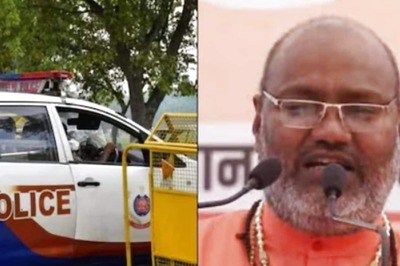
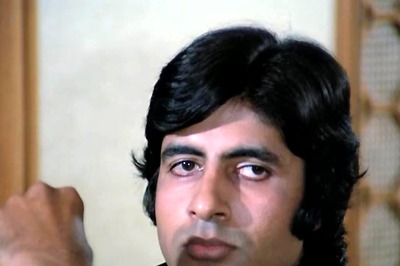

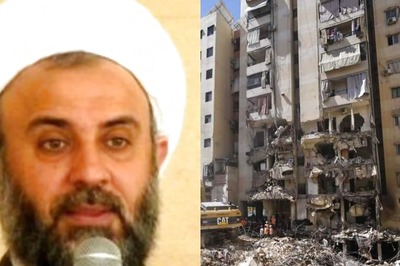
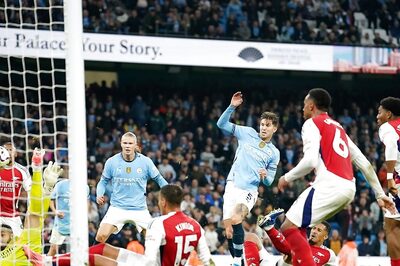

Comments
0 comment